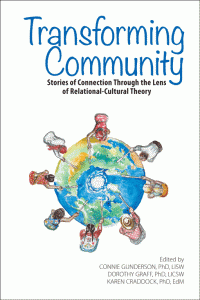Relational-Cultural Theory Series, Previous Articles:
What is Relational-Cultural Theory?
Transforming Community Through Disruptive Empathy
Combining the Neuroscience of Relational-Cultural Theory and Clinical Practice
RCT: The Power of Connection Through Student and Professional Mentorship
It’s All About the Relationship
By Julie Kim, MSW, LICSW
 From: Transforming Community: Stories of connection through the lens of Relational-Cultural theory
From: Transforming Community: Stories of connection through the lens of Relational-Cultural theory
Edited by: Connie Gunderson, PhD, LISW, Dorothy Graff, PhD, LICSW, & Karen Craddock, PhD, EdM
As a student counselor with Health Services at the University of Minnesota, Duluth, I am sharing a personal story relating insights and experiences about surviving systems of oppression to living. Learning about Relationship-Cultural theory (RCT) clarifies the impacts of racism and oppression and helps people of color move from survival and isolation to building a foundation to live a meaningful life. RCT reflects my values, validates my personal experiences, and has taught me about the power of connection and healing. Julie Kim may be contacted at juliek@d.umn.edu.
“It’s all about the relationship” is a phrase Connie Gunderson says quite often. It couldn’t be more true, as I reflect on my life journey so far. Relational-Cultural theory (RCT), developed by the work of Jean Baker Miller, identifies the concept of chronic disconnection, a disconnection which promotes condemned isolation to such a degree that relationships are feared and persons have a sense they do not deserve loving relationships filled with understanding.
As a Korean girl, adopted at a young age into a white family, and growing up in a predominantly white community, I began my journey into condemned isolation. Being told daily that I didn’t belong, I wasn’t wanted, and I needed to go back to my country was reinforced through people’s attitudes and by systems I was involved in every day. Always feeling a sense of being left out, of being different, I was a label of ridicule, especially because of my appearance. Hearing comments such as: “Chink, you would be cute if your eyes were bigger. Can you see out of your eyes?” was a normal occurrence. I experienced an additional sense of condemned isolation because, since I was not fully Korean, I didn’t fit into the American culture and I did not belong in my home country. “Where do I belong?” and “Where do I fit in?” were common questions that continued until I reached my early 30s.
Learning about racism and beginning to understand the personal consequences of racism turned my world into wonder, curiosity, and the unknown. “What am I supposed to do with this information?”, and “Will it change my life?” At the time I remember thinking: “It was never my fault.” This was a defining message that promoted internal change. I began to seek people who would support me for the way I looked; who understood my life experience; and who accepted my authentic self; an authentic self no longer ruled by fear, people’s glares, or by people asking me personal questions about whether or not I was a “foreigner”, or why I was in the United States.
Living authentically didn’t come easy at first. I constantly questioned myself about whether or not my perceptions and ideas were valid. However, as I moved into deeper questions and reflections, my relationships became deeper and more intentional. Feeling accepted and understood was profound and life changing and I started to believe “I do matter” because my relationships reinforced this every day.
My journey continues and I am constantly reminded of my story as I listen to college students of color share their experiences which are very similar to my own. My goal is to help them recognize that they are enough, their multiple identities matter, and to teach them to live authentically. I say this because I know that no one can do this work alone or in isolation. For example, I was provided the opportunity to teach an all student of color course and in doing so, we created an environment that was not influenced by institutionalized systems already in place. In looking back, the students and I created an environment from the basic tenets of Relational-Cultural theory that modeled interdependence, empathy, mutuality, and connection. SunNy Vang, a class participant, summed up the learning experience for all by stating:
My experiences with relationship building in our class began from a place of vulnerability. As a person of color, I struggle tremendously with a sense of belonging. Knowing that I do not “fit” nicely with what is considered normal or customary; I learned to appreciate it and to acknowledge that I have more to contribute to my community. These awarenesses did not happen overnight. We had discussions every day that reflected our reactions, thinking processes, and how we felt about a number of awesome and sad things. We all came from different places and our stories were welcomed. We connected on a far deeper level compared to other classes.
The students and I focused on building empathic relationships, and it truly fostered a responsive and relevant teaching and learning environment in ways that included much more than racial, social, and ethnic demographics. We supported each other by validating and embracing each other’s knowledge, values, experiences, and differences. We all became more mutually responsive persons. I’m truly grateful for the students, as their insights and experiences have helped me to grow and continue to heal. Connie Gunderson was right, “It’s all about the relationship”.
